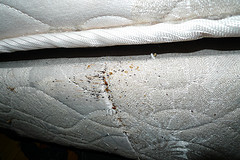
flickr.com/cuttlefish
Do you ever lay awake at night, and have the feeling that you’re not on your own? You are aware that there’s no one else in the room, but you just can’t shake the feeling that someone — or something — is right there beside you.
This is not a horror tale, at least not the B-movie type. It’s the story of the bed bug, a creepy creature that has caused more night sweats and sleepless nights than all of the horror movie characters combined. This unwanted bedmate is the lowly Cimex lectularius, ordinarily known as the Bed Bug.
Background
There are numerous different members of the bed bug family. The most ordinary goes by the scientific name of Cimex lectularius.
Experts believed that the very existence of bed bugs had been eradicated in the United States during the 1970s and 1980s. The insects have made a return, however, partly due to the increase of migration and travel from other countries.
Bed bugs are bloodsuckers that feed on the blood of humans and other warm-blooded animals. If you think that only you are victim to bed bug bites, you’re wrong. Pets are also ordinary hosts to these wingless pests. Cats, birds, dogs and virtually every species of mammal are susceptible to bed bug bites. Anything that comes into direct contact with an infested bed, carpet or sofa can be affected.
It’s difficult to spot bed bugs because of their diminutive size and their nocturnal habits. In the final phase of maturity, adult bed bugs grow to about ¼ inch in length. The pests are flat and oval shaped when viewed from top to bottom. The bugs are transparent when young, growing to white, then cream, then a darker brown shade as they get older. If a bed bug appears to be red, it’s likely it just had a big meal of blood.
Bug’s Life Span
After feeding from a host, an adult bed bug can live for over a year without sucking blood. Younger bed bugs need to feed more often and can live only a few months, or even just one month, without food. So even if a bed or other infested area remains vacant from pet or human contact for many months, there is a good chance that the bed bugs will survive. After an adult bed bug has three or four feeding sessions, it will lay numerous eggs and complete its life span.
Their Habitat
Bed bugs usually thrive in dark places within the home. It is the insect’s instinct to live within crevices and miniscule, dark places where they will not be easily detected and killed. In the home, bed bugs can be traced living in beneath or underneath of the bed. They will also thrive in the folds and creases of bedding and pillows. They remain undiscovered during the day, but very actively hunt for food at night. Bed bugs seem to be intelligent creatures, as they know to only attack when the hosts are completely relaxed — while sleeping.
Common Reactions
You may not realize that you have fallen prey to a bed bug bite until a day or two later. There is no pain or stinging sensation while being bitten. The bite will appear red, itchy and swollen as the skin begins to react to the insect’s saliva. It can be difficult to differentiate a bed bug bite from a mosquito bite.
Initial Control and Extermination
Bed bugs are difficult insects to control because of their small size and ability to survive without food. There are many insecticides and pesticides that can kill the insects, but of course, these are not safe to use where your family and pets live and sleep. Ask a pest control expert for professional advice on exterminating and controlling bed bugs. If you own your home, call local pest control operators in your location. If you are renting, it’s your landlord or superintendent’s responsibility to take necessary actions and end the infestation.
Bed bugs are definitely unwelcome housemates, but an infestation is not the end of the world. There are measures that you can apply and people that can help you to find a permanent solution.
Tagged with: bed bugs control • pests control
Filed under: Bed Bugs